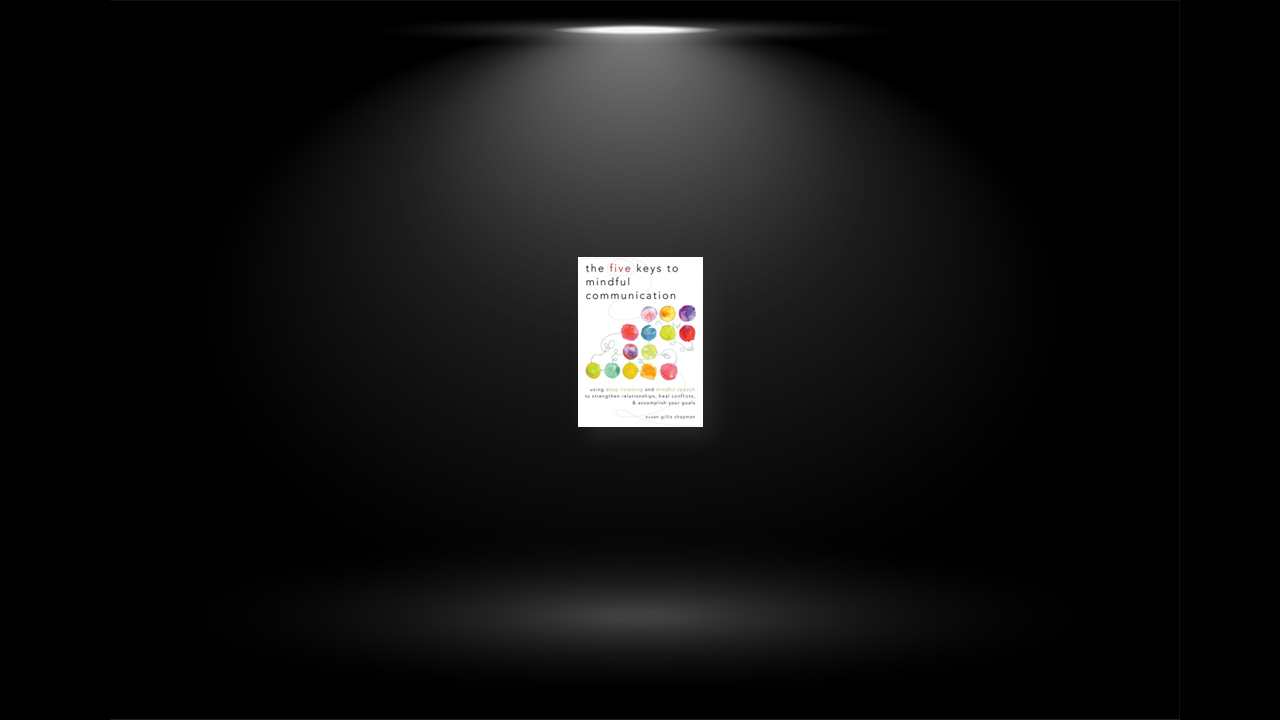The Key to Mindful Presence: Awake Body, Tender Heart, Open Mind
The starting point for genuinely listening to others is learning to listen to our own body, heart, and mind, the basic intelligence of the present moment. The slogan “Go with the green light” means we gain the power of mindful presence by learning to recognize these experiences and to cultivate them. Mindfulness meditation is an important way to do this.
Meditation trains our minds to pay attention by allowing thoughts to flow naturally rather than being captivated by them. Because our words are an expression of our thoughts, meditation is a powerful aid to relationship. Having a little quiet time when we can relax and accept ourselves as we are helps us be more open to others.
Practicing mindfulness meditation is taking a break from our struggle to survive. Instead of leaning toward our future plans or burdening ourselves with worries from the past, we can simply sit down and relax in the present moment. This is how the power of mindful presence dawns. Mindfulness meditation is more of an un-training than trying to do something new. Meditation tunes us in to the flow of our natural communication system. Let’s take a closer look at what this means. This communication system operates at the most fundamental level of our awareness, where we accommodate the first moment of an experience. The three ways we receive this information are.
- Awake Body: coming back to our senses
- Tender Heart: trusting our heart
- Open Mind: being open and flexible
The Key to Mindful Listening: Encouragement
Listening is like pouring tea into a cup. When the cup is clean and empty, we’re able to hear what the other person is saying clearly, and this is green-light listening. But when the conditions aren’t in place, we can’t listen and the light is red. One example of red-light listening is when the cup is upside down. This is when we have no interest at all in listening to the other person. Another example is when the teacup has a crack in it and the tea leaks out. This is when we’re trying to listen but our attention is out of control. And the third example is when the teacup has something else in it already, which is what happens when we’re full of toxic certainty. This is when we mix someone else’s story with our own and edit the two together. When these red-light patterns are habitual, communication can be blocked for years.
What happens to our natural confidence and encouragement when the flow of communication is blocked? Discouragement sets in. To understand the roots of our own discouragement, it’s important to pay close attention to what happens in our own hearts and minds at times like this. When the other person stops listening to us or misinterprets what we’re saying, a kind of crisis takes place. In those eyes we’ve turned from a living human being into an object. When toxic certainty or put-downs are added to the conversation, we can easily be triggered to relive painful frozen memories. Most likely we’ll scramble, trying to figure out what happened. This is that vulnerable time when our self-doubts surface. “What did I do wrong? Is there something wrong with me?”
A young mother was listening to her iPod through earphones while her toddler was excitedly looking out the window at the images flashing by. “Wazzat, Mama, wazzat!” he repeated over and over again. But his mother’s attention was somewhere else. The little boy’s initial joy turned into urgency: “Mama, Mama, wazzat, wazzat.” Still no response. You could practically see his spirits collapse into a two-year-old version of despondency.
Because we human beings are relationship oriented, our sense of self is shaped by experiences like this little boy had on the train. We don’t have to be two years old to feel an emotional impact when communication breaks down. But most of the time, like that little child, we don’t have a way to understand what is happening. To prevent a toxic authority from seizing control of our mind, we need to open up a friendly dialogue with the confusion that surrounds our inner discouragement.
The Key to Mindful Speech: Gentleness
It’s hard enough to speak mindfully under normal circumstances, but it is truly remarkable when we’re able to hold steady during a painful moment. When the best of our intentions are overwhelmed, the slogan “When the light turns red, stop” can remind us that there is a difference between the raw, unavoidable distresses of life—primary experiences—and the unnecessary suffering created by mindless reactions. Becoming intimate with pain as well as with our negative reactions helps us be willing to transform our speech into gentleness.
Speaking gently increases the chances that what we say will be heard. By refraining from exaggerations or generalizations we can maintain a we-first perspective when we’re angry or in pain. Speaking our truth is tricky. Mindfulness practice helps us investigate our motivations for expressing ourselves. Are we engaged in a “two-way-street” conversation or do we shut down the traffic with a one-way broadcast? Mindfulness shows us that everything we say is colored by our unique perceptions, our interpretations, and our emotional reactions. Recently, when a twenty-four-hour news TV network opened in Canada, a local journalism professor effectively asked, “How much of this information is news and how much is opinion?” This is the question we ask ourselves when we’re practicing mindful speech.
Speaking gently isn’t about being “nice,” suppressing our rough edges like a naughty child. That kind of niceness turns our aggression inward in a mindless-heart style. Real gentleness comes from knowing that curiosity and empathy are more reliable defenses than opinion and reactivity. It comes from knowing that we need to protect our sense of connectedness, our relationships, rather than put up barriers around our personal territory. Our natural communication system is subtle, like the pulse a physician reads by holding a firm but light touch on our wrist. We feel this pulse with awake body, tender heart, and open mind. Staying open, even in conflict, allows communication to flow both ways. Gentleness tracks the pulse of the relationship, informing us of the effect our words are having on our listeners.
The Key to Mindful Relationships: Unconditional Friendliness
Unconditional friendliness comprises the qualities of openness, trust, and accommodation. When we talk about making friends with ourselves, this is what we mean. This friendship is unconditional because it is more fundamental than the editor in our mind, the impulse to divide things into “I like” and “I don’t like.” When we activate this friendship, our direct experience of reality—happy or sad, painful or pleasurable—is like a constantly present companion that we can learn to rely on.
What we mean by “unconditional” is open mind, the awareness that recognizes the flowing quality of our everyday experience. And we use the idea of “friendliness” to express tender heart, the ability to feel joy when we’re touched by the beauty of what we experience. For we live and love in what Japanese poets call “a floating world.” We practice unconditional friendliness by gently challenging the misunderstandings that surface.
We need to reconnect with curiosity and the natural clarity of our mind. With inquisitive thinking, we look closely and analyze what happens when a reaction starts to build; in that way we can recognize our blind spots. For example, you arrive at the bank moments after it closes. That little disappointment called “irritation” can become a fuse that might lead to an explosion with your partner on the way home. Whether or not that happens might depend on many factors—whether or not you had a cup of espresso that afternoon, how easy it was to find a parking place, what the weather conditions in your relationship have been like over the past few days. But regardless of the contributing factors, that moment can either make or break an otherwise peaceful relationship.
Unconditional friendship with our own sensitive feelings means that we become curious about the origins of our sense of shame, embarrassment, regret, hurt, insult, irritation—all the rough edges of human relationships. Practicing inquisitive thinking, we turn around and look directly at the chain of misunderstandings that make uncomfortable situations worse. How do these surface reactions suppress the more vulnerable emotional experiences we don’t want to feel, such as core fears that we are unlovable, unworthy, or unforgivable?
Feeling cut off from love and joy causes us to reach outside ourselves for these feelings, a choice that always let us down. Sometimes we can notice this playing itself out in the middle of a conversation. This is the microscopic level where the cycle of relationship turns from hope to disappointment in a matter of seconds. When we pause or feel cut off by someone’s barrier, we fall from the Summer of feeling connected back into the Winter of aloneness. The shock of suddenly feeling ourselves out in the cold, being on the other side of a closed communication door, contributes to the fear that we’re unlovable. It is a flashback to early childhood when being misunderstood by someone we cared about was excruciatingly painful.
The key to mindful relationship is realizing that we are always both alone and together. Unconditional friendliness shows us this paradoxical truth. We are born with the ability to appreciate beauty and to love, even though we know we can’t hold on to things. Seeing this gives us the courage to genuinely love other people as they are rather than as we wish they could be.
The Key to Mindful Responses: Playfulness
The key to mindful responsiveness is the playfulness that arises when we’re open, unburdened by preconceived ideas and strategies. This is the path of the artist whose intention is to express the beauty of human experience, a heroic beauty that can be found even in the midst of tragic circumstances. The mindfulness practice to develop the power of playfulness is called surfing the wave of coincidence, a practice of entering situations with no agenda other than to be of help and listening for clues as to what to do or not do.
The obstacle to responding mindfully in the present moment is to be distracted by strategies based on preconceived ideas from the past or ambitions about outcomes in the future. All kinds of controlling behaviors block access to the playfulness of the present moment. Letting go of these controls and opening to the messages from awake body, tender heart, and open mind, we enter a conversation with all the elements in our environment and learn to dance with the energy of the present moment.


